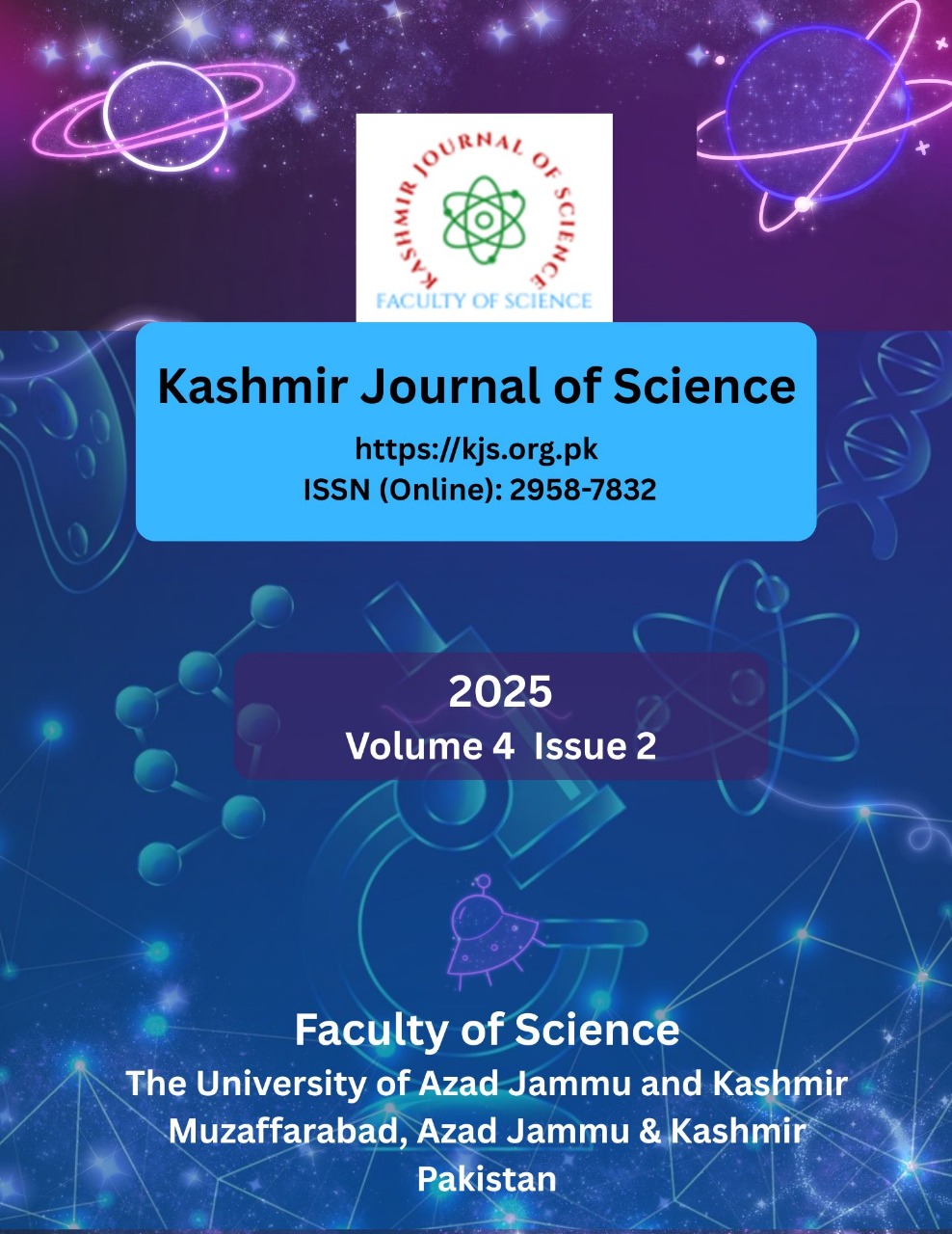The Comparative Study on Quality Characteristics of Ice Cream Developed from Camel and Buffalo Milk
A Comparative analysis of Camel and Buffalo Milk Ice cream
DOI:
https://doi.org/10.63147/krjs.v4i2.146Keywords:
Camel Milk, Buffalo Milk, Ice Cream, Physicochemical Propertoes, Sensorial attributesAbstract
Abstract
Modern consumers demand natural, nutrient-rich foods that may have additional biological benefits. This growing demand motivates food researchers and manufacturers to develop new innovative formulations of ice cream enriched with different ingredients. Camel milk is gaining popularity around the globe owing to its great nutritional composition, therapeutic properties, and trending food-related uses. The present study was undertaken to compare the physicochemical and sensorial attributes of ice cream samples prepared from camel milk (CM), and buffalo milk (BM) and with their combination. For this reason, three formulations were set for preparing ice cream samples, i.e., T1= ice cream with 100% CM, T2= ice cream with 100% BM, and T3= ice cream with 50% CM and 50% BM, and were assessed for their physicochemical and sensorial properties. The analysis of the attributes was performed using standard analytical methods. The results regarding the physicochemical and sensorial properties of all ice cream treatments were statistically different (p < 0.05). The results revealed that T2 showed to have significantly higher average values for protein (6.51%), fat (6.98%), ash (0.98%), titratable acidity (0.33%), and viscosity (314.00 cp) whereas T3 showed to have significantly higher average values for pH (6.14), color (8.66), consistency (9.0), taste (8.66), flavor (8.33), and overall acceptability (9.00). It may be concluded from the present study that among all three ice cream samples T2 proved to have suitable physicochemical properties. Moreover, T3 exhibited higher average values for pH and sensorial attributes therefore it is recommended that T2 had good nutritional value while T3 perceived good average scores for all sensorial attributes.
Keywords: Camel milk, Buffalo Milk, Ice cream, Physicochemical properties, Sensorial attributes
References
AOAC, (2016). Official methods of analysis of AOAC international. 20th Edition. Association of the Official Analytical Chemists, Gaithersburg.
Arain, M.A., Khaskheli, G.B., Shah, A.H., Marghazani, I.B., Barham, G.S., Shah, Q.A., Khand, F.M., Buzdar, J.A., Soomro, F. and Fazlani, S.A. (2023). Nutritional significance and promising therapeutic/medicinal application of camel milk as a functional food in humans and animals: A comprehensive review. Animal Biotechnology, 34(6), 1988-2005.
Baig, D., Sabikhi, L., Khetra, Y. and Shelke, P.A. (2022). Technological challenges in the production of camel milk cheese and ways to overcome them–A review. International dairy journal, 129, 105344.
Baloch, M.H., Shah, A.H., Rajput, M.N., Barham, G.S., Khaskheli, G.B., Magsi, A.S. and Behan, A.A. (2019). Influence of thermal treatments on physico-chemical properties of camel versus buffalo milk. Sindh University Research Journal-SURJ (Science Series), 50(3), 405-412.
Bilal, R.M. (2021). Physiochemical and sensory characteristics of ice cream from lassi camel milk. Pak-Euro Journal of Medical and Life Sciences, 4(3), 191-194.
Chen, Z., Xie, Y., Luo, J., Chen, T., Xi, Q., Zhang, Y. and Sun, J. (2020). Milk exosome-derived miRNAs from water buffalo are implicated in the immune response and metabolism process. BMC Veterinary Research, 16, 1-5.
Du, C., Deng, T., Zhou, Y., Ye, T., Zhou, Z., Zhang, S., Shao, B., Wei, P., Sun, H., Khan, F.A. and Hua, G. (2019). Systematic analyses for candidate genes of milk production traits in water buffalo (Bubalus Bubalis). Animal Genetics, 50(3), 207-216.
Elkot, W.F., Ateteallah, A.H., Al-Moalem, M.H., Shahein, M.R., Alblihed, M.A., Abdo, W. and Elmahallawy, E.K. (2022). Functional, physicochemical, rheological, microbiological, and organoleptic properties of synbiotic ice cream produced from camel milk using black rice powder and Lactobacillus acidophilus LA-5. Fermentation, 8(4), 187.
FAO. Available online: https://www.fao.org/faostat/en/#home (accessed on 1 July 2023).
Genovese, A., Balivo, A., Salvati, A. and Sacchi, R. (2022). Functional ice cream health benefits and sensory implications. Food Research International, 161, 111858.
Gomez, K.A., Gomez, A.A. (1984). Statistical procedures for agricultural research. John Wiley & sons.
Hajian, N., Salami, M., Mohammadian, M., Moghadam, M. and Emam-Djomeh, Z. (2020). Production of low-fat camel milk functional ice creams fortified with camel milk casein and its antioxidant hydrolysates. Applied Food Biotechnology, 7(2), 95-102.
Hammam, A.R. (2019). Compositional and therapeutic properties of camel milk: a review. Emirates Journal of Food and Agriculture, 31(3), 148-152.
Ho, T.M., Zou, Z. and Bansal, N. (2022). Camel milk: A review of its nutritional value, heat stability, and potential food products. Food Research International, 153, 110870.
Issimov, A. (2024). Camel Milk Processing Opportunities: A Review. Preprints. Doi: 10.20944/preprints202405.0410.v1.
Iwe, M.O. (2002). Handbook of sensory methods and analysis. Rojoint Communication Services Ltd., Enugu, Nigeria, 7-12.
Jafarpour, A. (2017). Feasibility of manufacture and investigation of physicochemical properties of camel milk–based ice cream. Journal of Scientific Agriculture, 1, 300-302.
Jiang, M., Meng, Z., Cheng, Z., Zhan, K., Ma, X., Yang, T., Huang, Y., Yan, Q., Gong, X. and Zhao, G. (2022). Effects of buffalo milk and cow milk on lipid metabolism in obese mice induced by high fat. Frontiers in nutrition, 9, 841800.
Khalifa, M.I. and Zakaria, A.M. (2019). Physiochemical, sensory characteristics and acceptability of a new set yogurt developed from camel and goat milk mixed with buffalo milk. Advances in Animal and Veterinary Sciences, 7(3), 172-177.
Khaskheli, M., Arain, M.A., Chaudhry, S., Soomro, A.H. and Qureshi, T.A. (2005). Physico-chemical quality of camel milk. Journal of Agriculture and Social Sciences, 2, 164-166.
Khedkar, C.D., Kalyankar, S.D. and Deosarkar, S.S. (2016). Buffalo Milk. In B. Caballero, P. Finglas, & F. Toldrá (Eds.), The Encyclopedia of Food and Health (Vol. 1, pp. 522–528). Elsevier Ltd.
Malik, T.F. and Panuganti, K.K. (2023). Lactose intolerance. National Library of Medicine.
Mohamed, H., Nagy, P., Agbaba, J. and Kamal-Eldin, A. (2021). Use of near and mid-infrared spectroscopy for analysis of protein, fat, lactose, and total solids in raw cow and camel milk. Food Chemistry, 334, 127436.
Mohammed, N.K., Badrul Khair, M.F., Ahmad, N.H. and Meor Hussin, A.S. (2022). Ice cream as functional food: A review of health‐promoting ingredients in the frozen dairy products. Journal of Food Process Engineering, 45(12), e14171.
Mullaicharam, A.R. (2014). A review on medicinal properties of camel milk. World Journal of Pharmaceutical Sciences, 237-242.
Muthukumaran, M.S., Mudgil, P., Baba, W.N., Ayoub, M.A. and Maqsood, S. (2023). A comprehensive review on health benefits, nutritional composition, and processed products of camel milk. Food Reviews International, 39(6), 3080-3116.
Rafiq, S., Huma, N., Pasha, I., Sameen, A., Mukhtar, O. and Khan, M.I. (2015). Chemical composition, nitrogen fractions, and amino acids profile of milk from different animal species. Asian-Australasian journal of animal sciences, 29(7), 1022.
Sagar, S.P., Mehta, B.M., Wadhwani, K.N., Darji, V.B. and Aparnathi, K.D. (2016). Evaluation of camel milk for selected processing-related parameters and comparisons with cow and buffalo milk. International Journal of Health, Animal Science and Food Safety, 3(1).
Salem, S.A., Meead, G. and El-Rashody, F.M. (2017). Physicochemical and sensory properties of ice cream made from camel milk and fortified with date products. International Journal of Humanities, Arts, Medicine, and Sciences, 5, 29-40.
Sayar, E., Sengul, M. and Urkek, B. (2022). Antioxidant capacity and rheological, textural properties of ice cream produced from camel's milk with blueberry. Journal of Food Processing and Preservation, 46(3), 16346.
Servillo, L., D’Onofrio, N., Neglia, G., Casale, R., Cautela, D., Marrelli, M., Limone, A., Campanile, G. and Balestrieri, M.L. (2018). Carnitine precursors and short-chain acylcarnitines in water buffalo milk. Journal of Agricultural and Food Chemistry, 66(30), 8142-8149.
Soni, V. and Goyal, M. (2013). The potential of using camel milk for ice cream making. Journal of Camel Practice and Research, 20(2), 271-275.
Yadav, A.K., Kumar, R., Priyadarshini, L. and Singh, J. (2015). Composition and medicinal properties of camel milk: A Review. Asian Journal of Dairy and Food Research, 34(2), 83-91.
Downloads
Published
Issue
Section
License
Copyright (c) 2025 Abid Ali Buledi

This work is licensed under a Creative Commons Attribution-NonCommercial 4.0 International License.
This work is licensed under CC BY-NC 4.0







